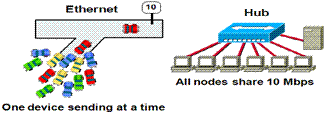Early Local Area Networks
The earliest Local Area Network technologies that were installed widely were either thick Ethernet or thin Ethernet infrastructures. And it’s important to understand some of he limitations of these to see where we’re at today with LAN switching.With thick Ethernet installations there were some important limitations such as distance, for example. Early thick
Ethernet networks were limited to only 500 meters before the signal degraded.In order to extend beyond the 500 meter distance, they required to install repeaters to boost and amplify that signal.There were also limitations on the number of stations and servers we could have on our network, as well as the placement of those workstations on the network.
The cable itself was relatively expensive, it was also large in diameter, which made it difficult or more challenging to install throughout the building, as we pulled it through the walls and ceilings and so on. As far as adding new users, it was relatively simple.There could use what was known as a non-intrusive tap to plug in a new station anywhere along the cable.And in terms of the capacity that was provided by this thick Ethernet network, it provided 10 megabits per second, but this was shared bandwidth, meaning that that 10 megabits was shared amongst all users on a given segment.
A slight improvement to thick Ethernet was thin Ethernet technology, commonly referred to as cheaper net.This was less expensive and it required less space in terms of installation than thick Ethernet because it was actually thinner in diameter, which is where the name thin Ethernet came from.It was still relatively challenging to install, though, as it sometimes required what we call home runs, or a direct run from a workstation back to a hub or concentrator.And also adding users required a momentary interruption in the network, because we actually had to cut or make a break in a cable segment in order to add a new server or workstation. So those are some of the limitations of early thin and thick Ethernet networks.An improvement on thin and thick Ethernet technology was adding hubs or concentrators into our network. And this allowed us to use something known as UTP cabling, or Unshielded Twisted Pair cabling.

As you can see indicated in the diagram on the left, Ethernet is fundamentally what we call a shared technology.And that is, all users of a given LAN segment are fighting for the same amount of bandwidth. And this is very similar to the cars you see in our diagram, here, all trying to get onto the freeway at once.This is really what our frames, or packets, do in our network as we’re trying to make transmissions on our Ethernet network. So, this is actually what’s occurring on our hub.Even though each device has its own cable segment connecting into the hub, we’re still all fighting for the same fixed amount of bandwidth in the network.Some common terms that we hear associated with the use of hubs, sometimes we call these Ethernet concentrators, or Ethernet repeaters, and they’re basically self-contained Ethernet segments within a box.So while physically it looks like everybody has their own segment to their workstation, they’re all interconnected inside of this hub, so it’s still a shared Ethernet technology.Also, these are passive devices, meaning that they’re virtually transparent to the end users, the end users don’t even know that those devices exist, and they don’t have any role in terms of a forwarding decision in the network whatsoever, they also don’t provide any segmentation within the network whatsoever.And this is basically because they work at Layer 1 in the OSI framework.
Collisions: Telltale Signs

A by-product that we have in any Ethernet network is something called collisions. And this is a result of the fundamental characteristic of how any Ethernet network works.Basically, what happens in an Ethernet network is that many stations are sharing the same segment. So what can happen is any one of these stations can transmit at any given time.And if 2 or more stations try to transmit at the same time, it’s going to result in what we call a collision. And this is actually one of the early tell-tale signs that your Ethernet network is becoming too congested. Or we simply have too many users on the same segment.And when we get to a certain number of collisions in the network, where they become excessive, this is going to cause sluggish network response times, and a good way to measure that is by the increasing number of user complaints that are reported to the network manager.
Other Bandwidth Consumers

It’s also important to understand fundamentally how transmissions can occur in the network. There’s basically three different ways that we can communicate in the network. The most common way is by way of unicast transmissions.And when we make a unicast transmission, we basically have one transmitter that’s trying to reach one receiver, which is by far the most common, or hopefully the most common form of communication in our network.

Another way to communicate is with a mechanism known as a broadcast. And that is when one transmitter is trying to reach all receivers in the network.So, as you can see in the diagram, in the middle, our server station is sending out one message, and it’s being received by everyone on that particular segment.

The last mechanism we have is what is known as a multicast.And a multicast is when one transmitter is trying to reach, not everyone, but a subset or a group of the entire segment.So as you can see in the bottom diagram, we’re reaching two stations, but there’s one station that doesn’t need to participate, so he’s not in our multicast group. So those are the three basic ways that we can communicate within our Local Area Network.

